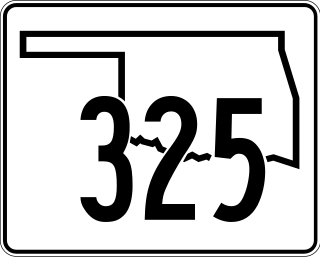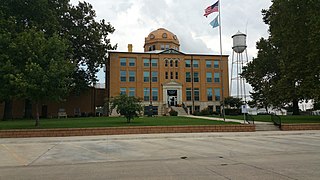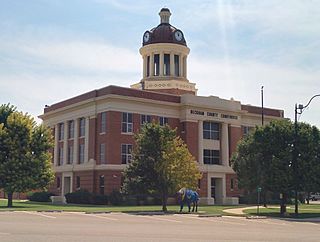
Cimarron County is the westernmost county in the U.S. state of Oklahoma. Its county seat is Boise City. As of the 2020 census, its population was 2,296, making it the least-populous county in Oklahoma; and indeed, throughout most of its history, it has had both the smallest population and the lowest population density of any county in Oklahoma. Located in the Oklahoma Panhandle, Cimarron County contains the only community in the state (Kenton) that observes the Mountain Time Zone. Black Mesa, the highest point in the state, is in the northwest corner of the county. The Cimarron County community of Regnier has the distinction of being the driest spot in Oklahoma ranked by lowest annual average precipitation, at just 15.62 inches; at the same time, Boise City is the snowiest location in Oklahoma ranked by highest annual average snowfall, at 31.6 inches.

Boise City is a city in and the county seat of Cimarron County, in the Panhandle of Oklahoma, United States. The population was 1,166 at the 2020 census, a decline of 7.9 percent from 1,266 in 2010.

Chandler is a city in, and the county seat of, Lincoln County, Oklahoma, United States. and is part of the Oklahoma City Metropolitan Area. The population was 2,858 at the time of the 2020 census. Chandler is located northeast of Oklahoma City on SH-66 and I-44, and north of Shawnee on SH-18.

U.S. Route 412 is an east–west United States highway, first commissioned in 1982. U.S. 412 overlaps expressway-grade Cimarron Turnpike from Tulsa west to Interstate 35 and the Cherokee Turnpike from 5 miles (8.0 km) east of Chouteau, Oklahoma, to 8 miles (13 km) west of the Arkansas state line. It runs the entire length of the Oklahoma Panhandle and traverses the Missouri Bootheel.

Felt is a small unincorporated community and census-designated place (CDP) in Cimarron County, Oklahoma, United States. As of the 2020 census, the town’s population was 77. It was named for C.F.W. Felt of the Santa Fe Railroad. Nearby is the Cedar Breaks Archeological District, included on the National Register of Historic Places listings in Cimarron County, Oklahoma. The community is served by a post office and a school. During the Great Depression in 1936 a farm in Felt was the site of the iconic Dust Bowl photograph known as Dust Bowl Cimarron County, Oklahoma.

Kenton is a town in Cimarron County, Oklahoma, United States. As of the 2020 census, the community had 31 residents.

State Highway 325, officially, SH-325, is a 38.08-mile (61.28 km)state highway [{Cimarron County, Oklahoma|Cimarron County]], Oklahoma, United States, that connects New Mexico State Road 456 to the traffic circle in Boise City that includes U.S. Route 56, U.S. Route 64, U.S. Route 287, U.S. Route 287, U.S. Route 412 and Oklahoma State Highway 3. Along the way it provides access to Black Mesa State Park, near Black Mesa, the highest point in the state of Oklahoma.

The Guthrie Historic District (GHD) is a National Historic Landmark District encompassing the commercial core of Guthrie, Oklahoma, US. According to its National Historic Landmark Nomination it is roughly bounded by Oklahoma Avenue on the north, Broad Street on the east, Harrison Avenue on the south, and the railroad tracks on the west; it also includes 301 W. Harrison Avenue. The National Historic Landmarks Program on-line document describes the boundaries as "14th Street, College Avenue, Pine Street and Lincoln Avenue. One building, the Logan County Courthouse, is at 301 E. Harrison Avenue, outside the main boundaries of the GHD," This article relies on the former source, which is more detailed. According to the 1998 nomination, the proposed district covered 31 acres (13 ha). The nomination included 112 resources, classed as 69 contributing buildings, 38 non-contributing buildings, 1 non-contributing structure and 3 noncontributing objects. It was declared a National Historic Landmark in 1999 for its historic significance as the first capital of the Oklahoma Territory and of Oklahoma.

The Blaine County Courthouse in Watonga, Oklahoma was built in 1906, the year before Oklahoma received statehood. It has been asserted to be "one of the most imposing structures in Watonga" and it "serves as a landmark for both the town and the county," Blaine County. It has a large central dome, a pedimented entrance, and a pediment above its cornice whose tympanum is painted with spirals and the date "1906". Its front facade also features an arcade of three arched windows on the third and fourth story levels.

This is a list of the National Register of Historic Places listings in Garfield County, Oklahoma.

The United States Post Office and Courthouse, Oklahoma City, Oklahoma is a historic post office, courthouse, and Federal office building built in 1912 and located at Oklahoma City in Oklahoma County, Oklahoma. It previously served as a courthouse of the United States District Court for the Western District of Oklahoma, and of the United States Court of Appeals, briefly housing the Eighth Circuit and, then the Tenth Circuit for several decades. It was listed on the National Register of Historic Places in 1974. It continues to house the Bankruptcy court for the Western District of Oklahoma. The building includes Moderne and Beaux Arts.

Solomon Andrew Layton was an American architect who designed over 100 public buildings in the Oklahoma City, Oklahoma area and was part of the Layton & Forsyth firm. Layton headed partnerships in Oklahoma from 1902 to 1943; his works included the Canadian County Jail in El Reno, Oklahoma State Capitol, sixteen Oklahoma courthouses, and several buildings on the University of Oklahoma campus. Layton had a considerable influence on Oklahoma City architecture, and he became known as the "dean of Oklahoma City architecture"
Layton & Forsyth was a prominent Oklahoma architectural firm that also practiced as partnership including Layton Hicks & Forsyth and Layton, Smith & Forsyth. Led by Oklahoma City architect Solomon Layton, partners included George Forsyth, S. Wemyss Smith, Jewell Hicks, and James W. Hawk.

The Texas County Courthouse is the historic courthouse serving Texas County, Oklahoma, located in the city of Guymon. The building is a four-story, red-brick structure; its fourth floor once functioned as a jail. The courthouse was designed by Maurice Jaynes using classical styles and built by the Kriepke Construction Co., a prominent builder in Oklahoma, for $200,000. Opened in 1927, the courthouse received praise from local newspapers in its first decade and came to symbolize the success and growth of the Oklahoma Panhandle. On August 24, 1984, the courthouse was added to the National Register of Historic Places.
The Cold Spring and Inscription Rock Historic District is a 2-acre (0.81 ha) historic district in Cimarron County, Oklahoma, near Boise City, Oklahoma that was listed on the U.S. National Register of Historic Places in 1994. It is associated with NPS Master Plan #122. The district includes a landscape; it includes two contributing buildings and two other contributing sites.

The Beckham County Courthouse, located in Courthouse Square in Sayre, is the county courthouse of Beckham County, Oklahoma. The courthouse is considered a local landmark because it is the tallest building in Sayre. It is also one of the few courthouses in Oklahoma that has a dome.

The LeFlore County Courthouse, on Courthouse Square in Poteau in Le Flore County, Oklahoma, was built in 1926. It was listed on the National Register of Historic Places in 1984.

The Oklahoma Publishing Company Building, also referred to as the Daily Oklahoman Building, is an historic structure on 4th and Broadway in Oklahoma City. It was built for the publishing company behind The Oklahoman. It was designed by Solomon Layton and built in 1909 after the paper's previous building was destroyed by fire. It is listed on the National Register for Historic Places. Layton also designed the Oklahoma State Capitol, governor's mansion, numerous county courthouses, public schools, and other significant structures.

The Bryan County Courthouse in Durant, Oklahoma, located at 4th Avenue and Evergreen Street, was built in 1917. It was designed by architect Jewell Hicks. It was listed on the National Register of Historic Places in 1984.

The Owyhee County Courthouse in Murphy, Idaho, is a 1-story Art Deco building designed by Tourtellotte & Hummel and constructed in 1936. The brick building features a prominent entry with fluted pilasters on either side of a square arch, with foliated sunburst panels that frame an entablature of floral, triangular, and wavelet designs. A panel above the entry reads, "Owyhee County Courthouse." The building was added to the National Register of Historic Places in 1982.



















